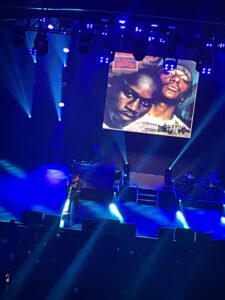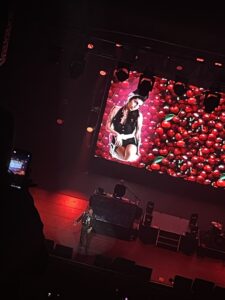Albeit from the nosebleeds, in 2021, at the Premier Theater, a vast performance hall located inside of the Foxwoods Resort Casino in Connecticut, I checked “See my favorite rapper in concert” off my king-sized bucket list. While the bulk of the audience spluttered with joy, and sang along to the intricate lyrics, I spent my time in a zen-like headspace, locked-in on the performance, hoping to pick up a thing or two from witnessing a master at his craft.
Right before Nas took the stage, all the lights went out. While the place was pitch back, the ‘Take it in Blood’ beat began to echo throughout the area. Right off the bat, I had chills. Seconds later, the illuminants returned, and the legendary hip hop figure arrived on the set. Donning his iconic “QB’ chain, in honor of his Queensbridge roots, Nas began rapping along to the song. He would go on to perform more songs of his platinum selling record, It Was Written, while also mixing in all the classics off of Illmatic. Hearing songs like “The Message”, “I Gave You Power”, “N.Y. State of Mind” and “The World Is Yours”, in person was nothin short of spectacular. As a big fan of his output, I had been listening to these songs for years. Whether it be in the car, at the gym, or in my bedroom, Nas’ catalog has always brought me immense joy so to get see him perform live was just awesome.
Since he had just recently dropped new material, Nas also sprinkled in joints off of his latest albums, King’s Disease & King’s Disease II. Aside from his own projects, he also performed some of his celebrated guest features, most notably his bars from the song ‘Eye for an Eye (Your Beef is Mines)’ , a cut off of Mobb Deep’s noteworthy album, The Infamous. Nas is my favorite rapper, and Mobb Deep is my favorite duo/group, so this was easily one of the coolest moments of the show for me. It’s one thing to rap along to the lyrics, “Rappers I monkey flip ’em with the funky rhythm I be kickin’ /Musician, inflictin’ composition, of pain /I’m like Scarface sniffin’ cocaine /Holdin’ a M16, see with the pen I’m extreme” while listening with headphones at the gym, but it’s ‘nother level when the artist who penned the complex rhymes is spitting them on stage while you’re in attendance.

RIP Prodigy! And RIP to Amy Winehouse, who Nas also showed love to when he performed his part in their song, Cherry Wine. Though I’m primarily a hip hop guy, I love Amy Winehouse and without a doubt believe that her sophomore LP, Back to Black, is one of the ten best albums of all-time.

Aside from his work itself, one of the reasons I became such a huge fan of Nas was his background. He grew up in the 70s inside the Queensbridge Housing Projects in New York. The development houses were broken down into two complexes, 40th side North, and 41th side South. Around this time, an inflow of African American travelers from the South, as well as immigrants from the Caribbean and South America, piled into the Empire State, in hopes of a better course. This wave of people assumed that they could raise a family and live a decent life on a low-wage manufacturing job, the type of career that New York City had been known to offer. Little did they know, because of the upcoming recessions, most notably the fiscal crisis in 1975, these aspired roles were vanishing from the city just as these immigrants entered. All of the respectable positions were predominately held, so, with an influx of migrators, New York City had incidentally welcomed a welfare generation. In ’79, they did a study and found that out of all the metropolitan areas in the nation, New York had the worst violent crime rate, meaning New Yorkers were committing evils like murder, rape, aggravated assault, and robbery at a higher degree than any other group.
Just when people thought it couldn’t get any worse, BANG. Cocaine hits the streets. New York had already had a heroin problem, but in the 80s, crack had taken over. By ’85, over 20 million Americans were using the deadly drug. Now picture this. The most menacing metropolitan area, filled with impoverished, wild savages, is now high on crack. In ’88, New York, with an estimated 600,000 citizens using crack, tallied nearly 2,000 homicides, the most recorded murders in a year for the community. Researchers noted that at least 40% of these deadly attacks were drug-related. Not to mention that 80 percent of all criminals in the state had tested positive for drugs. The city did their best to combat the virulent epidemic, hiring thousands of cops, and passing every possible law they could against drug dealers. This definitely slowed down the hellish behavior, but the damage had been done. Countless lives lost, and a crime rate that catapulted to the moon. The appalling dose of violence was so widespread, victims of car-theft and other forms of burglary started to not even bother reporting the crimes, as they knew those in law-enforcement didn’t have time to focus on robbery cases when there were murders happening left and right. With a measure of mothers abusing crack, thousands of babies were born with serious maladies. By the early 90s, nearly two million New Yorkers were deemed “poor”, which was about 25 percent of the state’s population. Among those underprivileged, 75 percent of them were black or Hispanic. Those families who travelled up north for a better life, unwittingly strolled into outright lunacy.

Amidst the hysteria, was a young, poetic, polymath named Nasir bin Olu Dara Jones, aka “Nas”. Jones was born in ’73, and was raised in the Queensbridge Houses. Nas’ prominent, youth years took place at a time where the senseless behavior was at its height in the city. A fervent fan of music, particularly hip hop, Nas began writing raps as a child, and when he was a teen, renowned dudes in the hip hop game (Most notably, Large Professor from Main Source) starting to take notice of his unparalleled flow and scuzzy libretto. Fast forward to ’92, the Queensbridge parodist inked a deal with Columbia Records, a preeminent record label. Two years later, Nas ‘monkey-flipped’ the game with his debut album, Illmatic. It was like a movie for life in Queensbridge. Nas gave us a first-person narration of the superincumbent actualities of street life in an anapestic tone that few artists have ever been able to replicate. Surrounding himself with some of the top producers in the game (Q-Tip, Large Professor, LES, Pete Rock, and DJ Premier), he rapped about the harsh reality of living in the projects, racial discrimination, crime, drug-akin imprisonment, oppression, and more. Basically, Nas painted a picture of what it was like to grow up in Queensbridge at the pinnacle of the madness. You could be anywhere in the world, but after listening to the album, you would be able see, touch, smell, hear, and taste the squalid streets of Queens.

The most sensational element in Nas’ lyrics on the album is that he doesn’t glorify the extreme behavior of life in the streets, or even spew hatred on his reality. Rather than that, Nas, in journalistic fashion, simply reported what he sees when he walks out the door. He would state the alarming substance, yet remain densely optimistic about it all. Yeah, sometimes the environment we are born into ain’t the most glorious, but you can’t let your present-day circumstances define your future.
All in all, Nas determined that Queensbridge project-living would not be his reality, identified a path to get out, and put in the work until his goals were reached.

